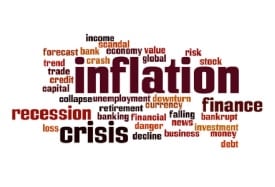Biden Spending To Build Back Stagflation
President Joe Biden signed a $1.2 trillion “infrastructure” bill into law on Monday amid growing concerns that his administration’s policies are fueling higher inflation.
Former Treasury Secretary Larry Summers, a Democrat, is warning of an economically and politically ruinous inflation problem brewing.
He wrote in a recent Washington Post op-ed that “far too much fiscal stimulus and overly easy monetary policy” will “threaten prosperity and public trust unless clearly acknowledged and addressed.”
That was an apparent swipe at the Biden administration’s pattern of denials and misdirections whenever confronted about inflation.
Joe Biden himself has bizarrely insisted that his spending package won’t cost anything because it is “paid for.” Of course, if the government really had the resources to pay for his “Build Back Better” programs, then it wouldn’t be running a $2.8 trillion annual budget deficit.
Biden has even asserted that his spending programs will reduce inflation. Perhaps he slept through Economics 101 and missed the lesson on how fiscal and monetary stimulus affect prices in the economy.
Meanwhile, Treasury Secretary Janet Yellen is doing a media blitz to deflect blame for surging consumer costs. “It’s important to realize that the cause of this inflation is the pandemic,” Yellen attempted to argue on CBS’s "Face the Nation” Sunday.
Based on that line of reasoning, price instability will be with us for as long as the virus is with us.

And officials seem to be as hopelessly unable to defeat the virus as they are stubbornly unwilling to fight inflation.
As the threat of prolonged inflation, or even stagflation, rises – and as the Fed continues to downplay the need for action – gold has perked up nicely.
The bulls appear to be gaining control of the market. If we see strong follow-through on last week’s gold rally, a leap over the key $1,900 level could be in the cards near term.
A major driver of gold buying right now is rising inflation fears. It does not take an economics degree to see that rising prices combined with massive supply bottlenecks are not good for the economy or for consumers.
In fact, recent data pointed to the highest levels of inflation in 30 years, and it could be just getting started.
The latest release of the Consumer Price Index, or CPI, showed an annualized rise of 6.2% and the Producer Price Index came in at 8.6%. As prices have continued to rise at a scary pace, even the Fed is now trying to wiggle out of its oft-repeated “transitory inflation” line.
A further rise in prices may not only have a deleterious impact on the American consumer, it but may also force the Fed to take action.
The central bank thus far, however, has attempted to ignore the inflation problem. Having already backed itself into a corner, the Fed now sees no way to appease markets while calming inflation. If it gets even further behind the inflation curve, the consequences could be severe and long-lasting.
Despite the Fed’s nonchalant tone when it comes to inflation, investors appear to see what may be coming down the road.
The threat of higher prices could not only affect the consumer but could even drive the economy back into a full-blown recession.
The Fed has made clear that even though it plans on reducing its monthly security purchases (QE), rate hikes need not follow the end of QE. In other words, the central bank may elect to maintain ultra-low interest rates for a year or more.
Through years and years of zero percent interest rates, negative real interest rates, and quantitative easing, the Fed has backed itself into a corner from which there may be no escape.
If the Fed keeps its foot on the gas, the effects could be devastating over the long term.
That’s why many investors are now scrambling to get their hands on physical gold and silver. This is one of the few asset classes available that tends to perform well during stagflation – a period of economic misery that may come to define the Biden administration.
Disclaimer: Information contained herein has been obtained from sources believed to be reliable, but there is no guarantee as to completeness or accuracy. Because individual investment ...
more


